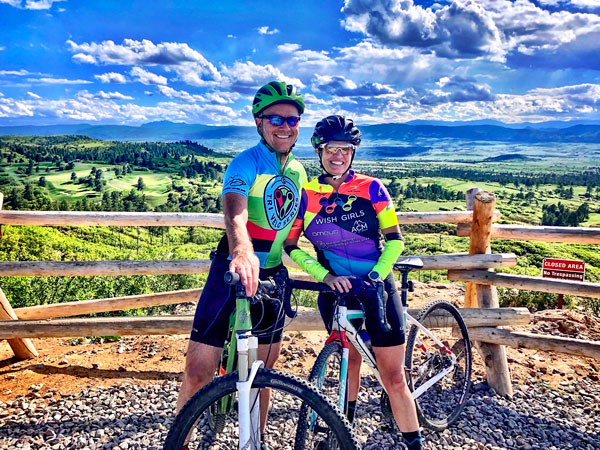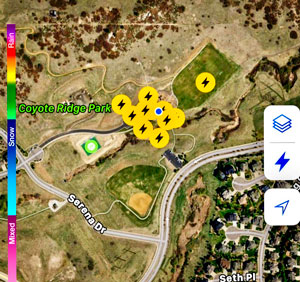When lightning strikes
By Lisa Nicklanovich; photo courtesy of Michelle Barton

Michelle Barton and Clint Bickmore pause for a photo while biking in Daniels Gate Park. Barton was caught in a severe thunderstorm while cycling in July. Barton said she was, “scared to death” while sheltering at Coyote Ridge Park, but was able to get a safe ride home where she decided to refresh her knowledge about lightning. “If you’re out in nature, you need to know what to do in a crazy emergency situation,” Barton said.
Michelle Barton was out biking when she was caught in a thunder and lightning storm last month. “It was the craziest thing I’ve ever been through,” Barton said. After hearing thunder, she decided to turn around. When it continued, she decided to get off her bike and find shelter. She weathered the storm at Coyote Ridge Park and said, “I was very lucky as cloud-to-ground lightning hit only a few yards away.”
Barton is not only an avid cyclist, she has also completed more than 20 14ers and an Ironman Triathlon, so she knows to be weather-aware in Colorado. Thunderstorms often strike with little to no warning; if this can happen to Barton, it can happen to anyone.
While the chances of getting struck by lightning are slim, injuries can occur by making contact with an object electrified by lightning. There are some steps you can take to lessen your chances of injury.
According to the National Weather Service, if you are caught outdoors and unable to find an indoor shelter, look around for the lowest place possible such as a ravine or valley and distance yourself as much as you can from any and all conductors. For example:
- Leave open fields, elevated mountain tops, and watery areas.
- Avoid picnic tents, pavilions, or other open, outdoor structures and avoid structures with concrete flooring as lightning can travel through any metal wires or bars in concrete walls or flooring.
- Move as far away as possible from isolated objects such as lone trees.
- Distance yourself from any possible metal conductors such as wires, fences, long metal structures like bleachers, hiking poles, camera tripods, backpacks with metal frames, etc.
If lightning is about to strike near you, your hair may stand on end, or you may feel a tingling in your skin. Light metal objects may vibrate. Barton said that right before she heard a huge clap of thunder (her ears were ringing the next day), she did feel the electricity in the air and heard a sizzle. Barton crouched down between two picnic benches.

With a lightning app on her phone, Michelle Barton captured this cloud-to-ground illustration of the lightning right over her at Coyote Ridge Park. The blue dot represents Barton. As she looked around, there was a metal play structure, a bathroom with a metal chimney and street lights — all metal objects that are high from the ground and lightning conductors.
Barton was right to crouch down. If you detect any of these signals of energy in the air, assume it is lightning and crouch immediately; squat in a baseball catcher’s position – on the balls of your feet with your heels touching, ears covered, and head between your knees. This is a difficult position to hold but the idea is to minimize your contact with the ground and make it easier for a lightning strike to flow over your body rather than through you.
For more information, visit the National Oceanic and Atmospheric Administration at www.noaa.gov/weather and search for lightning safety. Also, visit www.14ers.com for safety suggestions if you are going to climb a 14er.